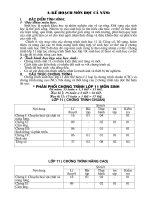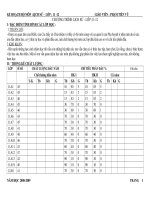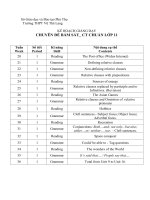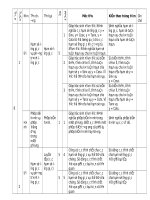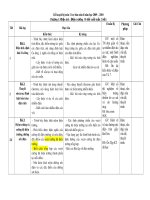ke hoach giang day 11
Bạn đang xem bản rút gọn của tài liệu. Xem và tải ngay bản đầy đủ của tài liệu tại đây (184.61 KB, 9 trang )
<span class='text_page_counter'>(1)</span><div class='page_container' data-page=1>
Kế hoạch giảng dạy Tiếng Anh 11 Học kì 1
Số bài dạy : 16 bài
Nội dung kế hoạch: Đọc, Nói, Nghe, Viết & Ngữ pháp & Kiểm tra
Unit
Period
Skills
Aims
<b><sub>Teacher’s activities</sub></b>
<b><sub>Student‘s activities</sub></b>
Teaching aids
<b>Unit 1:</b>
<b>Friendship</b>
<b>1</b>
<b>Reading</b>
Developing such
reading micro-skills as
scanning for specific
ideas , skimming for
general information
and guessing
meaning in context
Using information
they have read to
discuss the topic
Having Ss work in pairs to discuss
the picture in Before You read part
Giving instructions by guessing
the given words in task 1
Getting to work individually to
search for the main ideas
Giving Ss skills to do task 3
Working in pairs to discuss
the picture
Guessing the meaning of the
given words and doing the
task
Working individually to do
task 2
Working in pairs to answer
the questions
Textbooks
Handouts
<b>2</b>
<b>Speaking</b>
Describing the
physical
characteristics and
personalities of their
friends, using
appropriate adjectives
Asking Ss to work in pairs to
describe the people in the picture
in task 1
Explaining some adjs and then
getting them to discuss and
number the personalities in order
of importance in friendship
Asking Ss to work in pairs to
perform the interview
Working in pairs to do the
task
Discussing and numbering
the order of importance in
friendship
Working in pairs to do task 3
Textbooks
Handouts
<b>3</b>
<b>Listening</b>
Developing such
listening micro-skills
as intensive listening
for specific
information and taking
notes while listening
Instructing Ss to use some
strategies in task 1 and doing the
task
Asking them to fill in the table with
the things they remember the
previous times of listening
Using the suggestions to do
task 1
Working individually to fill in
the table in task 2
Textbooks
Handouts
Cassette
tapes
<b>4</b>
<b>Writing</b>
Writing about a friend,
real or imaginary,
using expressions
and words that they
have learnt in
previous in task 2
Giving the form of a writing and
having the whole class read the
tasks and the guidelines silently to
write about
Having SS exchange their writings
and checking the answers
Reading the tasks as the
teacher instructs
Exchanging their writings
Textbooks
Handouts
<b>5</b>
<b>Language</b>
<b>Focus</b>
Distinguishing the
sounds / d3/ & / tS/
Pronouncing the
words and sentences
containing these
sounds correctly
Using some
structures containing
Infinitves with and
without to
appropriately
Instructing Ss to pronounce 2
sounds
Reviewing some structures
containing Infinitves with and
without to
Checking the given exercises
Practising the 2 sounds
Using the grammar to do the
given tasks
</div>
<span class='text_page_counter'>(2)</span><div class='page_container' data-page=2>
<b>Unit 2 :</b>
<b>Personal</b>
<b>Experiences</b>
<b>6</b>
<b>Reading</b>
Developing such
reading micro-skills as
scanning for specific
ideas. identifying of
the events and
guessing meaning in
context
Using the information
they have read to
discuss the story
getting Ss to read the passage
silently and do Task 1 by guessing
the given words
Having Ss read the text again and
discuss the sequence of the
picture
Giving instructions to do task 3
Reading the passage silently
and do task 1
Discussing the sequence of
the picture and do task 2
Using skills to do task 3
Textbooks
Handouts
<b>7</b>
<b>Speaking</b>
Identifying structures
that are used to talk
about past
experiences and their
influences on one s <b>’</b>
life
Using these
structures to talk
about past
experiences and how
it affects their life
Getting Ss to do task1 individually
and compare their answer with a
peer
Having Ss work with a partner and
work out the sequence of the
converstation
Getting Ss to work in pairs to have
a converstion using the suggested
questions and task2
Doing the task individually
and comparing their answers
Working with a partner and
doing task2
Working in pairs and carrying
out the conversations using
suggestions
Textbooks
Handouts
<b>8</b>
<b>Listening</b>
Developing such
listening micro-skills
as listening for
specific information
and taking notes while
listening
Preteaching vocabulary
Getting Ss to read through theses
statements and underline key
word in task 1
Having Ss fill in the task 2 by
reading the statements carefully
and listen
Reading through the
statements
and do task 1
Filling in the blanks by usingsome technics the teacher
has given
Textbooks
Handout
Cassette
tapes
<b>9</b>
<b>Writing</b>
Writing a personal
letter about a past
experience , using the
structures and
vocabulary
Getting Ss to work invidually and
work out what they are required to
do
Getting Ss to plan their stories
using suggested questions and
having Ss write in 10m
Asking SS to exchange their
writing then checking
Planning their stories based
on suggestions
Writing in 10mm and then
exchanging
Textbooks
Handouts
<b>10</b>
<b>Language</b>
<b>Focus</b>
Distinguishing the
sounds /m/, /n/, and /
η]
Distinguishing the
uses of different verbs
tenses
Distinguishing 3 sounds
Reviewing all the verb tenses
Instructing Ss to the given tasks
Practising 3 sounds
Using the verb tenses to do
the tasks
Textbooks
Handouts
<b>11</b>
<b>Test : 45 minutes – No 1</b>
<b>12</b>
<b>Corrections for the test</b>
<b>Unit 3 :</b>
<b>A party</b> <b>13</b> <b>Reading</b> Developing such reading micro-skills as
scanning for specific
ideas. identifying and
Giving some newwords
Giving them some tips to do task 1
& 2
Getting Ss to read and do task 1
Working individually to do
task 1
Working in pairs to do task 2
Working in group of 4 or 5 to
</div>
<span class='text_page_counter'>(3)</span><div class='page_container' data-page=3>
correcting false
statements silentlyHaving Ss to work in pairs and do
task 2
Asking Ss to work in groups of 4
or 5 to do After You Read part
do the rest part
<b>14</b>
<b>Speaking</b>
Using appropriate
language to talk about
parties and negotiate
how to plan them
Using appropriate
language to invite
people to come to
parties
Introducing task 1 and going over
the questions with the whole class
and then asking them to choose
the details they want to talk about
Putting SS in pairs and getting
them to tell each other about their
parties – task 2
Dividing the class into 4 groups to
do task 3
Having Ss to inform their parties
and invite them to come – task 4
Doing task 1 with the whole
class
Working in pairs to do task 2
Forming 4 groups to do task
3
Informing the parties they
have palnned and inviting
their friends to come in task 4
Textbooks
<b>15</b>
<b>Listening</b>
Developing such
listening micro-skills
as intensive listening
for specific
information
Preteaching vocabulary
Giving Ss some tips to do task 1
& 2
Playing 2 or 3 times and then
checking
Having Ss sumarise what they ve <b>’</b>learnt
Using the skills to do task 1
and task 2
Giving their answers
Sumarising main points of the
listening text
Textbooks
Handout
Cassette
tapes
<b>16</b>
<b>Writing</b>
Defining the format
and structure of an
informal letter of
invitation
Writing in informal
letter
Having Ss work in pairs and
answer the given questions in task
1
Getting Ss to do task 2 individually
and compare their answer with a
peer
Asking Ss to do task 3 in groups
of 4 to write a letter of invitation
Elicting Ss answers<b>’</b>
Working in pairs to do task 1
Doing task 2 individually
Doing task 3 in group of 4
Giving the writings to the
teacher
Textbooks
Handouts
<b>17</b>
<b>Language</b>
<b>Focus</b>
Distinguishing the
sounds / l/, /r/ , / h/
Distinguishing the
uses of infinitive and
gerund in active and
passive
Distinguishing 3 sounds
Reviewing the uses of Infinitive
and gerund
Instructing Ss to do the given
tasks
Practising 3 sounds
Using the grammar points to
do the given tasks
Textbooks
Handouts
<b>18</b>
<b>Test yourself A</b>
<b>Unit 4:</b>
<b>Volunteer</b>
<b>work</b>
<b>19</b> <b>Reading</b> Developing such
reading micro-skills
as scanning for
specific ideas ,
skimming for general
information
Giving some newwords
Giving them some tips to do task
1, 2 & 3
Getting Ss to read and do task 1
individually and then exchange
the answers
Having Ss to work silently and do
task 2
Getting Ss to work in pairs to do
Working individually to do
task 1 & 2
Working in pairs to do task 3
Working in group of 4 or 5 to
do the rest part
</div>
<span class='text_page_counter'>(4)</span><div class='page_container' data-page=4>
task 3
Asking Ss to work in groups of 4
or 5 to do After You Read part
<b>20</b>
<b>Speaking</b>
Talking about
different kinds of
activities related to
volunteer work
Having Ss work in pairs and
deciding that activities are
volunteer work in task 1
Getting Ss to work in pairs and
do task 2
Dividing the class into 4 groups
to discuss task 3
Providing help if neccessary
Working in pairs to do task
1, & 2
Forming 4 groups to do task
3
Presenting what they have
discussed
Textbooks
Handouts
<b>21</b>
<b>Listening</b>
Developing suchlistening micro-skills
as intensive listening
for specific
information and
taking notes while
listening
Preteaching vocabulary
Giving Ss some tips to do task 1
& 2 ( filling missing information and
taking notes)
Playing 2 or 3 times and then
checking
Having Ss sumarise what they ve<b>’</b>
learnt
Using the skills to do task 1
and task 2
Giving their answers
Sumarising main points of
the listening text
Textbooks
Handouts
Cassette
tapes
<b>22</b>
<b>Writing</b>
Writing a thank-you
letter to a donar to
acknowledge the
donar s contribution<b>’</b>
Reminding Ss the form of an
formal letter
Preparing Ss to write by asking
them to read and do task 1 as
the sample letter
Getting Ss to read the
requirements of task 2 carefully
and write in 15 mm
Having Ss exchange their writing
and then checking
Reading and doing task 1
individually
Doing task 2 in 15mm
Exchanging their writings
Noting down corrections
from the teacher
Textbooks
<b>23</b>
<b>Language</b>
<b>Focus</b>
Distinguishing the
sounds / w/, /j/
Using Gerunds,
present paritciples,
perfect gerund &
perfect participles
appropriately
Distinguishing 2 sounds
Reviewing the uses of Gerunds,
present paritciples, perfect
gerund & perfect participles
Instructing Ss to do the given
tasks
Practising 3 sounds
Using the grammar points to
do the given tasks
Textbooks
Handouts
<b>24</b>
<b>Test : 45 minutes – No 2</b>
<b>25</b>
<b>Corrections for the test</b>
<b>Unit 5 :</b>
<b>Illiteracy</b> <b>26</b> <b>Reading</b> Developing such reading micro-skills
as scanning for
specific ideas,
identifying main ideas
and identifying
meaning in context
Giving some newwords
Giving them some tips to do task
1, 2 & 3( Finding the Vietnamese
equivalances , choosing the main
ideas and answering questions)
Getting Ss to read and do task 1
in pairs by guessing the
meanings
Having Ss to work silently and do
Working in pairs to do task 1
Working individually to do
task 2 and exchanging the
answers
Doing task 3 in pairs
Working in groups of 4 or 5
to do the rest part
</div>
<span class='text_page_counter'>(5)</span><div class='page_container' data-page=5>
task 2
Getting Ss to work in pairs to do
task 3
Asking Ss to work in groups of 4
or 5 to do After You Read part
<b>27</b>
<b>Speaking</b>
Talking about
schooling and literacy
prblems
Suggesting solutions
to these problems
Having Ss work in pairs and
match A with B
Dividing the class into 4 groups
to talk about Ss school problems<b>’</b>
and offer solutions
Having Ss work in groups of 4
again and talk out 3 or 4
problems and offer solutions
Working in pairs and do task
1
Forming groups of 4 and do
task 2
Working in groups of 4 and
do task 3
Textbooks
<b>28</b>
<b>Listening</b>
Developing extensive
listening skills
Using the information
they have listened to
for other
communicative tasks
Preteaching vocabulary
Giving Ss some tips to do task 1
& 2 ( Choosing the best options and
answering questions)
Playing 2 or 3 times and then
checking
Having Ss discuss After you read
part ...
Giving feed back
Using the skills to do task 1
and task 2
Giving their answers
Discussing After you read
part
Presenting ideas
Textbooks
Handouts
Cassette
tapes
<b>29</b>
<b>Writing</b>
Interpreting
inforamation
presented in tables
Identifying language
to be used for
describing tables
Writing descriptions
of tables
Preparing Ss to write by
preteaching words and phrases
using to describe a table
Getting Ss to read task 1 and do
it with their peers
Helping Ss analyse and organise
the writings to do task 2
Having them work individually in
15 mm
Giving corrections and feedback
Reading and doing task 1
with their peers
Doing task 2 individually in
15mm
Noting down corrections
from the teacher
Textbooks
Handouts
<b>30</b>
<b>Language</b>
<b>Focus</b>
Distinguishing the
sounds / pl/, /bl/, / pr/,
/br/ and pronouncing
the words and
sentences containing
them correctly
Understanding
reported speech with
infinitives and using
these structures to
solve communicative
tasks
Distinguishing 4 sounds
Reviewing the uses of reported
speech with infinitives
Instructing Ss to do the given
tasks
Practising 3 sounds
Using the grammar points to
do the given tasks
Textbooks
Handouts
<b>Unit 6:</b>
<b>Competitions</b>
<b>31</b> <b>Reading</b> Developing such
reading micro-skills
as scanning for
specific ideas,
identifying main ideas
and identifying
Giving some newwords
Giving them some tips to do task
1, 2 & 3( Matching words ,
answering questions and Filling
missing information)
Getting Ss to read and do task 1
Working in pairs to do task
1,2 and exchanging the
answers
Doing task 3 individually
Working in groups of 4 or 5
to do the rest part
</div>
<span class='text_page_counter'>(6)</span><div class='page_container' data-page=6>
meaning in context in pairs by guessing the
meanings
Having Ss to work with their
partners and do task 2
Getting Ss to work individually to
do task 3
Asking Ss to work in groups of 4
or 5 to do After You Read part
<b>32</b>
<b>Speaking</b>
Asking for and giving
information about
types of competitions
talking about a
competition or
contest
Introducing task 1 and getting Ss
to do it individually and then
cpmpare answers with peers
Explaining the examples and
usefull languages and having
them work in pairs to do task 2
Putting Ss into 3 or 4 groups to
do task 3( offering help if
neccesary)
Sumarising main points
Doing task 1 individually and
comapring with partners
Working in pairs to do task 2
Working in groups to do task
3 and then giving answers
infront of the class
Textbooks
Handouts
<b>33</b>
<b>Listening</b>
Developing extensive
listening skills
Using the information
they have listened to
for other
communicative tasks
Preteaching vocabulary
Giving Ss some tips to do task 1
& 2 ( Ticking True or False and
answering questions)
Playing 2 or 3 times and then
checking
Having Ss discuss After you read
part ...
Giving feed back
Using the skills to do task 1
and task 2
Giving their answers
Discussing After you read
part
Presenting ideas
Textbooks
Handouts
Cassette
tapes
<b>34</b>
<b>Writing</b>
Writing a letter to
reply to the request of
information
Reminding Ss the form of an
formal letter
Preparing Ss to write by asking
them to read and do task 1 as
the sample letter
Getting Ss to read the
requirements of task 2 carefully
and write in 15 mm using the
given details
Having Ss exchange their writing
and then checking
Reading and doing task 1
individually
Doing task 2 in 15mm
Exchanging their writings
Noting down corrections
from the teacher
Textbooks
Handouts
<b>35</b>
<b>Language</b>
<b>Focus</b>
Distinguishing the
sounds / tr/, /dr/, / tw/,
/br/ and pronouncing
the words and
sentences containing
them correctly
Understanding
reported speech with
gerund and using
these structures to
solve communicative
tasks
Distinguishing 3 sounds
Reviewing the uses of reported
speech with gerund
Instructing Ss to do the given
tasks
Practising 3 sounds
Using the grammar points to
do the given tasks
Textbooks
Handouts
</div>
<span class='text_page_counter'>(7)</span><div class='page_container' data-page=7>
<b>37</b>
<b>Test : 45 minutes – No 3</b>
<b>38</b>
<b>Corrections for the test</b>
<b>Unit 7:</b>
<b>World</b>
<b>population</b>
<b>39</b>
<b>Reading</b>
Developing such
reading micro-skills
as scanning for
specific ideas,
identifying main ideas
and identifying
meaning in context
Preteaching vocabulary
Giving them some tips to do task
1 & 2( Filling gaps with the given
words , answering questions)
Getting Ss to read and do task 1
individually by guessing the
meanings
Having Ss to work with their
partners and do task 2
Asking Ss to work in groups of 4
or 5 to do After You Read part
Working individually to do
task 1 and exchanging the
answers
Doing task 2 in pairs
Working in groups of 4 or 5
to do the rest part
Presenting ideas
Textbooks
Handouts
<b>40</b>
<b>Speaking</b>
Talking about the
causes of population
explosion , problems
of population booms
and solutions to
these problems
Having Ss work in pairs to do
task 1 and then task 2
Getting Ss to do task 3 in groups
of 4 and work out the solutions to
the problems of overpopulation
Dividing the class into 2 groups,
one : talk about problems, one :
offer solutions to overpopulations
Giving feedback
Working in pairs to do task 1
& 2
Doing task 3 in groups of 4
to work out the solutions
Forming 2 groups to talk
problems and solutions to
the overpopulation
Giving presentation
Textbooks
Handouts
<b>41</b>
<b>Listening</b>
Developing such
listening micro-skills
as listening for
specific information
and listening for
general information
Preteaching vocabulary
Giving Ss some tips to do task 1
& 2 ( Choosing the best options and
answering questions)
Playing 2 or 3 times and then
checking
Having Ss discuss After you read
part ...
Giving feed back
Using the skills to do task 1
and task 2
Giving their answers
Discussing After you read
part
Presenting ideas
Textbooks
Handouts
Cassette
tapes
<b>42</b>
<b>Writing</b>
Writing descriptionsof pie charts , using
appropriate language
Preparing Ss to write by giving
Ss the form of describing a pie
chart and some useful languages
related to it
Asking Ss to analyse the chart
Having Ss work individually to
write and then exchange their
writing
Giving corrections and feedback
Analysing the given chart
Doing the task individually
Exchanging their writings
Noting down corrections
from the teacher
Textbooks
Handouts
<b>43</b> <b>Language</b>
<b>Focus</b> Distinguishing the sounds / kl/, /gl/, /
kr/,/ gr/, /kw/ and
pronouncing the
words and sentences
containing them
correctly
Using conditional
sentences (1,2,3) and
Distinguishing 4 sounds
Reviewing the uses of conditional
sentences (1,2,3) and
conditionals in reported speech
Instructing Ss to do the given
tasks
Practising 3 sounds
Using the grammar points to
do the given tasks
</div>
<span class='text_page_counter'>(8)</span><div class='page_container' data-page=8>
conditionals in
reported speech and
using these
structures to solve
communicative tasks
<b>Unit 8:</b>
<b>Celebrations</b> <b>44</b>
<b>Reading</b>
Developing such
reading micro-skills
as scanning for
specific ideas,
identifying main ideas
and identifying
meaning in context
Preteaching vocabulary
Giving them some tips to do task
1,2 & 3( Working out the
meaning of words ,ticking true or
false and answering questions)
Getting Ss to read and do task 1
individually by explaining the
meanings
Having Ss to work with their
partners and do task 2 and task 3
Asking Ss to work in groups of 4
or 5 to do After You Read part
Working individually to do
task 1 and exchanging the
answers
Doing task 2 and task 3 in
pairs
Working in groups of 4 or 5
to do the rest part
Presenting ideas
Textbooks
Handouts
<b>45</b>
<b>Speaking</b>
Talking about the
celebrations of Tet
and other festivals <b>’</b>
activities
Having Ss work in pairs and
practise reading the dialogue
Getting Ss in pairs to do task 3 &
4
Giving corrections and feedbacks
Working in pairs to do task 1
, 2 & 3 Textbooks
<b>46</b>
<b>Listening</b>
Developing suchlistening micro-skills
as intensive listening
for specific
information
Preteaching vocabulary
Giving Ss some tips to do task 1
& 2 ( Ticking True or False and
answering questions)
Playing 2 or 3 times and then
checking
Having Ss discuss After you read
part ...
Giving feed back
Using the skills to do task 1
and task 2
Giving their answers
Discussing After you read
part
Presenting ideas
Textbooks
Handouts
Cassette
tapes
<b>47</b>
<b>Writing</b>
Writing a description
of a popular
celebrations
Preparing Ss to write by asking
Ss to work out the outline of the
writing
Getting Ss to work individually to
describe the festival they have
chosen in 15 minutes
Having Ss exchange their
writings
Eliciting Ss writing to correct<b>’</b>
Giving corrections and feedback
Working the out line of the
writing
Working individually to write
in 15 minutes
Exchanging their writing
Noting down the corrections
from the teacher
Textbooks
Handouts
<b>48</b> <b>Language</b>
<b>Focus</b>
Distinguishing the
sounds / fl/, /fr/, / θr/
and pronouncing the
words and sentences
containing them correctly
Using one(s),
someone, no one,
anyone and everyone
appropriately
Using vocabulary
Distinguishing 3 sounds
Reviewing the uses of
nondefining pronouns
Explaining vocabulary about
holidays and celebrations
Instructing Ss to do the given
tasks
Practising 3 sounds
Using the grammar points
and vocabulary to do the
given tasks
</div>
<span class='text_page_counter'>(9)</span><div class='page_container' data-page=9>
about holidays and
celebrations
appropriately
Final test for the first term
<i><b>Tr</b></i>
<i><b> ờng THPT Nam Tiền Hải</b></i>
<b> Giáo viên : </b>
Ngun ThÞ Hoa
<b> </b>
<b> Tæ : X Héi</b>
·
</div>
<!--links-->

